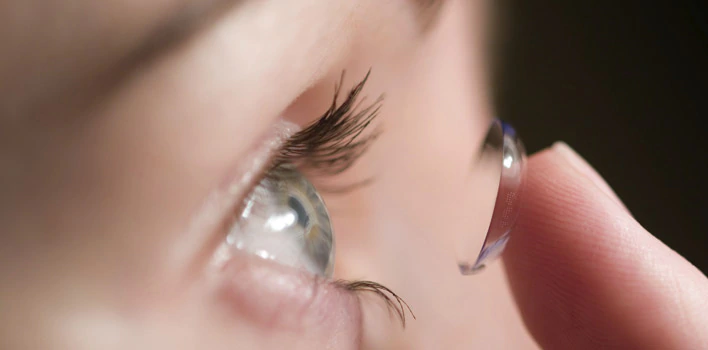Contact Lenses
Lens made of special materials attached to the front surface of the cornea to correct the refractive errors of the eye are generally called “contact lenses”. These lenses are placed on the front surface of the cornea and correct the refractive error of the eye, thanks to their optical refractors, and provide clearer vision.
Today, appearance and the discomfort of wearing glasses are the main reasons for wearing contact lenses. People who do not want to use sports activities, intense work pace or glasses prefer to use contact lenses.
It is necessary to wear contact lenses in order to obtain the best visual quality, especially in those who use high-grade glasses, those with a high difference between the two eyes, and those with irregular and high astigmatism. Not only these people, anyone who does not want to wear glasses and whose eye structures are suitable can use contact lenses.
Today, thanks to the needs of people and developing technology, many types of contact lenses are available. Despite being under many names and shapes, contact lenses can be examined under 4 main headings in general.
• Soft contact lenses
• Gas permeable lenses
• Rigid contact lenses
• Specially produced contact lenses
Soft Contact Lenses
They are lenses designed to completely cover the cornea and iris layer of the eye and to cover 1-2 mm more on the iris edge. Due to their soft structure, they fit snugly on the cornea and do not give the user a feeling of discomfort. They can stay in the eye for a long time depending on their oxygen permeability and water content. If used correctly, they do not harm the eyes, but if care is not taken into account, allergic problems may occur, as with all lenses. There are many subgroups of soft contact lenses. Soft lenses other than toric contact lenses are used to correct myopic and hypermetropic refractive errors, they have very little effect on correcting astigmatism.
Classic Long Term (Conventional) Contact Lenses:
• These are contact lenses that can be used daily or for a long time, with a lifespan of 3-12 months. Although they have a long lifespan, the deposits formed on them can cause allergic symptoms and problems in terms of eye health.
• Myopia or hyperopia flat clear lenses
• Myopic or hyperopia colored lenses: These are soft contact lenses used to make the iris color of the eye look different, with or without numbers.
• Toric (astigmatized) clear lenses: These are soft contact lenses specially produced for the correction of astigmatism as well as myopic or hyperopia refractive errors
• Toric (astigmatic) colored lenses
• Multifocal (far-close use) clear lenses: These are the lenses used in near vision impairment. It helps in correcting the far and near refractive error.
Planned Replacement Lenses:
The lenses used in these lenses are changed at certain times and the accumulations on the lens surface and related problems are minimized. Today, it is widely used all over the world and is preferred by doctors and people with refractive errors. Lenses can stay in the eye for a long time depending on the doctor’s advice and material properties. They are lenses that are easy to find and maintain with their wide production parameters.
Monthly Planned Exchange Lenses
• It is produced to be used for 30 days, it can stay in the eye for 1-30 days depending on the doctor’s advice and lens material properties.
• Myopia or hyperopia flat clear lenses
• Myopia or hyperopia colored lenses
• Toric (astigmatic) clear lenses
• Multifocal (far-near-used) clear lenses
• Progressive (far-near-use) clear lenses: These are lenses with a balanced distribution of near and far numbers used in near vision impairment. It helps in correcting the far and near refractive error.












